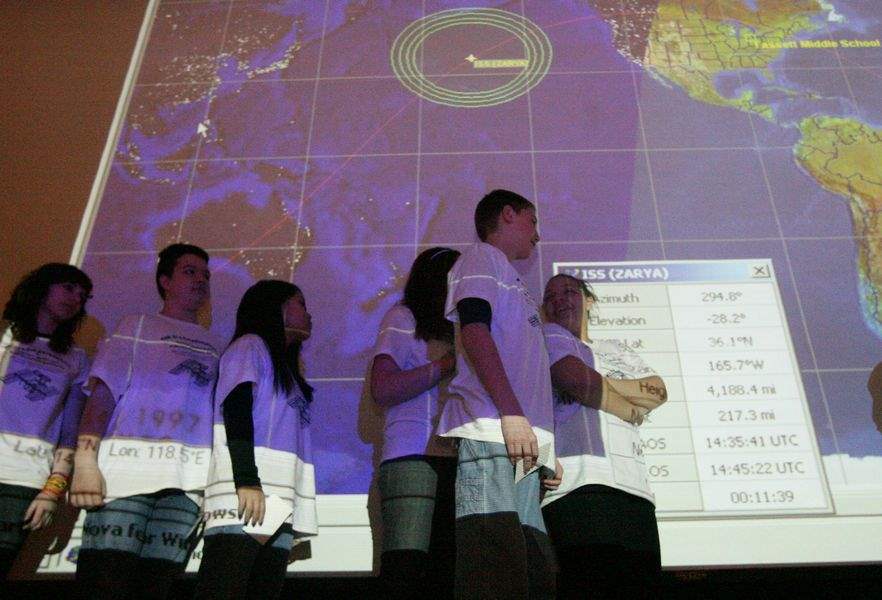
NASA program links up Fassett with International Space Station
2/24/2009
Students line up with their questions for the space station commander. They were in touch with the station for about 10 minutes.
The Blade/Amy E. Voigt
Buy This Image
Talk about long distance: Fassett Middle School students peppered an International Space Station astronaut with questions Monday as he orbited about 220 miles above North America at 17,500 miles an hour.
Using ham radio airwaves, 16 students at the Oregon school had nearly 10 minutes to pose questions to Michael Fincke, commander of the station s Expedition 18, as part of a NASA educational program. The Pennsylvania native, who is a colonel in the U.S. Air Force, is on his second space station trip.
Our planet is definitely incredible, Colonel Fincke told Fassett s about 550 students. I wish all of you could see what I m seeing right now.
The Toledo Mobile Radio Association supplied ham radio equipment that provided the connection between Colonel Fincke and Fassett. The exchange was part of a program called Amateur Radio on the International Space Station. It was really hurried, but luckily we got everything done in time, said Spencer Mizelle, a Fassett eighth grader. We got good answers. They were what we wanted to know. I learned a lot.

A map indicates the relative positions of the International Space Station and Fassett Middle School during the linkup.
Said sixth grader Emily Hook: It was awesome.
The NASA-arranged exchange has been a year in the making, and students were chosen for the privilege based on questions they submitted in preparation for yesterday s assembly, said Karina Hahn-Claydon, eighth grade science and math teacher.
Colonel Fincke, 41, was asked about the work he is doing on the space station with the crew s four other members, including a Russian cosmonaut and a Japanese astronaut. Expedition 18 launched to the space station in October, and the crew is scheduled to return in April.
When asked what skills are needed to be an astronaut, Colonel Fincke replied that math and science are critical. He said he also speaks Russian and Japanese, and knowing other languages is helpful both in space and on land.
Every day up here, I expect my crew to use their brain all the time, said Colonel Fincke, who said the crew is working on 30 to 40 experiments.
If someone breaks a bone, students learned, the astronauts all have training to aid the person, and doctors can be called for guidance. For very serious medical problems, they can return to Earth within a half day, Colonel Fincke said.
He answered more personal queries, such as how he keeps in touch with his wife and three young children. (He uses Voice-over-Internet Protocol to talk to his family daily.)
He was even asked how astronauts use the bathroom on the international space station. Colonel Fincke joked there was no way he could hold it for six months, explaining there are tanks for both urine and No. 2 waste on board.
Sponsored by the American Radio Relay League, Radio Amateur Satellite Corp., and National Aeronautics and Space Administration, the International Space Station program stresses the importance of science, technology, and learning.
Toledoan Steve Michalski, a member of the local association who also works with the space station s program, had asked Mrs. Claydon if she would be interested in doing an exchange at Fassett.
The program also demonstrates how ham radio is a good way to communicate, no matter where people are, Mr. Michalski said.
This is to show them that they really can do that, he said. Mike Fincke is actually in space, on the space station right now.
Contact Julie M. McKinnon at:jmckinnon@theblade.comor 419-724-6087.